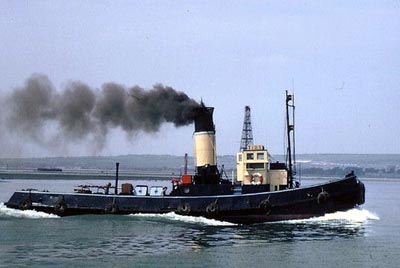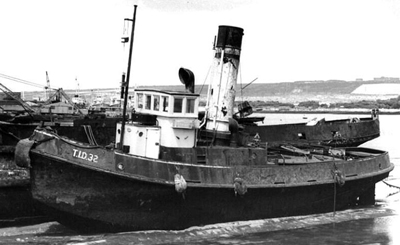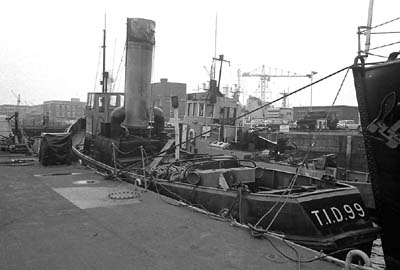|
TID Class Tugs at Portsmouth in the 1960s
By David Russell
|
| My first
experience of these vessels was in 1966 when, after spending two years
or so at sea on ocean tankers, I joined the Port Auxiliary Service at
HM Dockyard, Portsmouth as an Able Seaman and was sent to join the crew
of TID 32. She was one of three TIDs serving in the Dockyard Port at that
time, the others being TID 3 and TID 99. They were part of the largest
single class of tugs ever built in Britain, with a total of 182 vessels
being completed between 1944 and 1946.
In Admiralty Service in those days, the crew of a TID (we always took this acronym to mean "Towage - Inland Docks", although most naval historians have now concluded that it is more likely that it meant "Towing - Invasion Duties", as most of these vessels were built towards the end of World War II expressly for operations during the D-Day landings) was made up of a total of six people, a Skipper, usually of the rank of Mate-in-Charge, a Mechanician, in charge of the Engine Room, three Able Seamen and one Stoker. The Skipper and Mechanician shared the aft cabin and the Stoker and the three ABs, the accommodation down below forward. Both of these living spaces had coal fired stoves fitted and the one in the forward messdeck was actually a miniature cooking stove complete with an oven and plenty of hob space on top. This came in very handy on TID 32 for cooking Able Seaman Alfie Furlong's famous stew which was usually made up of all the bones and meat leftovers from the crews' family Sunday lunch together with lashings of lentils and other wholesome goodies and was absolutely delicious on a cold winter's day. It was usually started on a Monday morning and lasted us for most of the week with bits of stuff added each day to keep it going! It was always the job of the duty Ship-Keeper to light these stoves every morning on all three TIDs and it was quite an art retrieving a shovel full of hot coals from the boiler furnaces down below and carrying it up and down the steep companionway ladders to each of the stoves in turn to get the fire going and the kettle boiling ready for the regulation cup of Dockyard tea before getting under way for the first job of the day. No doubt we would have great difficulty in getting this method past "Health & Safety" nowadays! Of the three, TID 99 was the only oil fired boat, burning the now obsolete heavy black furnace fuel oil (FFO) which was still plentifully available at that time, due to the large number of steam turbine warships still in service with the Royal Navy. TID 32 and TID 3, along with several other vessels including the tug "Cannon" and a number of "VICs" (Victualling Inshore Craft) were coal fired and ran on good old traditional Welsh steam coal that had to be loaded by hand at the Coaling Berth round at Fountain Lake Jetty, normally once a week and stowed below in the bunkers.
|
| As far as
I can remember, none of our TIDs were ever fitted with any form of electrical
generator and so their working activities were almost exclusively confined
to daylight hours as it was a really long and time consuming exercise
rigging, lighting and trimming paraffin steaming lights that had to then
be hoisted up the mast or placed on hooks in the side-light boxes on the
wheelhouse. We did, however, have a 220v AC shore power cable for lighting
the accommodation when tied up alongside for the night. This arrangement did not affect our availability too much during the light summer evenings, but in winter we were always alongside with the boiler fires "Banked Up" for the night by around 1530 ready for the crew to clock out at the Main Gate at 1600. The lack of electrical power whilst under way also meant that we had no VHF radio either, although this was not a legal requirement then as it would be today. It did, however, mean that every time we finished a job, we had to return to our berth and use a landline telephone in order to find out what was happening next. In between jobs, we would normally berth alongside the hulk of an old World War One Six Inch Gunned Inshore Monitor that was moored on the Gosport side of Portsmouth Harbour and which we knew as the "Minerva". She is now owned by Hampshire County Council and has been restored to much of her original 1915 condition by the ship repairers at Hartlepool, reverting to her original name of "HM Monitor M33" and is now on display in No.1 Dry Dock in Portsmouth Historic Dockyard. She is thought to be one of only two surviving World War I British warships that still exist in the World. Most of our work was normally confined to moving barges and lighters or anything else that needed placing alongside operational ships or those undergoing refit around the Dockyard in order to supply the Navy with fuel, stores and ammunition etc. One of our other more "exciting" chores was Compass Swinging, which involved us putting a rope into the stern of a warship that was secured by her bows to a mooring buoy in the middle of the harbour and towing her slowly round and round in circles, sometimes for a whole day, whilst her compasses were calibrated. Talk about watching paint dry! Very occasionally we would be ordered to "Stand By" to assist a frigate or destroyer during berthing operations, but this was indeed very rare for a number of reasons. If we were ever given the job at all, it was usually because there were no other tugs available at the time and the fact that we had no radio communications, due to our total lack of electrical power, meant that by the time we actually established any sort of meaningful dialogue with the officers on the warship's bridge, the vessel was usually either safely alongside or too deeply in trouble for our meagre 220 Horsepower to do any good anyway! Indeed, I also suspect that it would have had to have been a very brave trainee Navigating Officer to have risked the wrath of his 1st Lieutenant by inviting a scruffy little tug belching black smoke anywhere within a million miles of his gleaming paintwork without very good reason! In the unlikely event that we were asked to assist, this usually involved nothing more than securing a short rope inboard from our bow post and pushing up gently until the vessel was securely alongside the jetty.
|
| One of the
real "Fun Jobs" that occasionally came our way was when the
Aircraft Carriers were testing their Steam Catapults after emerging from
a dockyard refit. The ship would be tied up alongside the dockyard wall
with her bows pointing out into the middle of the harbour and would fire
"Test Dummies", effectively large steel caissons equipped with
four aircraft wheels, from their catapults out into the middle of the
harbour.
The Harbour Police Launch would establish a safety exclusion zone in front of the carrier and, once the "All Clear" had been given, this contraption would come hurtling off the forward end of the ship's flightdeck to land in the water with a massive splash like an exploding depth charge. It was then the job of the TID to go and retrieve the thing, which usually possessed the towing characteristics of a "Fossilised Woolly Mammoth" and tow it back to the floating crane to be hoisted back aboard the carrier for another go. It was a bit like a dog chasing a ball and this would often carry on for several days before the Dockyard Authorities were satisfied that everything was working satisfactorily on board the carrier. These "Dummies" were usually part filled with water to simulate the weight of different aircraft types and they occasionally became damaged due to their somewhat violent employment, often to the extent that their buoyancy was compromised and it then became a race to recover them before they sank to the bottom of the harbour, never to be seen again! Although they had many similarities, all three of our TIDs also had their own very different individual characteristics, both in handling and appearance. TID 32 was the boat that I knew best, as I spent much more time aboard her than I did the other two and although she was very reliable around the harbour, she did not like extended long passages very much. On the odd occasion that we were sent round to the US Army Reserve Storage Facility that was then situated at Hythe near Marchwood on Southampton Water, in order to move some of their equipment back to Portsmouth for maintenance, it would not have been unusual for us to have to heave-to in the Eastern Solent in order to clean the boiler fires and dump the clinker over the side so as to maintain sufficient steam pressure before proceeding. Even then it would take us all day to get there and back! TID 3 was
originally built for the Royal Naval Armaments Department (RNAD) and
consequently sported a red line around her hull above the rubbing strake
and another around the funnel between the buff main section and its
black top (these stripes were blue or white on the PAS craft). Her most
striking difference, however, was the funnel itself which was about
one third shorter than the normal TID design and had a large wire mesh
"Spark Arrester" welded to the top of it which angled outwards,
making it look a bit like the funnel of a railway locomotive from the
old American Wild West. TID 99, probably because she was oil fired, was much easier to work as she did not seem to require the same degree of skill and expertise on the part of the Stokers as was so essential with coal firing. As long as the Duty Stoker flashed-up the boilers at the right time in the morning prior to the start of the working day, she would always have sufficient head of steam to get under way on time and this is probably the main reason that she outlasted the coal fired boats when the MOD finally decided to pay them off. Coal firing was a much more delicate balancing act and depended very much on the skill of the individual Stoker who had "Raked-Out" and "Banked-Up" the fires before going home the previous evening and how the furnaces responded the following morning when the dampers were opened again to raise steam for the new day's work. It was very often possible to actually tell which Stoker had been on watch overnight without even referring to the duty roster, just by the level of steam pressure in the boiler and the condition of the fires in the furnaces! As far as I remember, it was towards the end of the summer of 1967 that the MOD had decided to replace TID 32 with a small diesel tug that had been brought home to Portsmouth from Malta after spending some time mothballed in reserve out there. This was TANAC 35, one of a class of small tugs which were built in Canada during World War II to satisfy much of the same requirement as the TIDs were designed for in the UK. They were much more like a typical American tug design to look at with much more top hamper above deck level and this particular example was powered by a three cylinder Crossley two-stroke diesel engine of 270 Horsepower, driving a single screw which for some reason actually turned in the opposite direction to that in the TIDs, causing her to kick very violently to starboard when going "Full Astern". The method of controlling the TANAC's engine movements was quite unusual too, as it was necessary for the Engineer to stop the engine and shaft turning completely and then switch the inlet and exhaust valves back to front, before re-starting the engine in reverse in order to go astern. This frequently caused a certain amount of panic and apprehension, not to mention a few "hard landings" alongside, when the compressed air starting mechanism failed to start the engine in reverse whilst the tug was approaching a jetty! Once TANAC 35 had completed a refit and was ready for service, the whole crew of TID 32, including myself, transferred to her and TID 32 was eventually sent to H.G.Pounds' Shipbreaking Yard at Tipner in Portsmouth to be broken up for scrap. Of the other two, TID 3 was eventually cut up in experiments by a company called Controlled Thermic Lancing at Barking, Essex and TID 99 was eventually also sold to H.G.Pounds and scrapped at Portsmouth in the early 1970s. The story does not end there though, as I have recently discovered that there are at least three of these vessels still preserved and regularly "in steam", two in England and one in Finland (which actually burns wooden logs in its boiler furnaces) as well as a number that have been re-engined with diesel propulsion over the years and are still in commercial use in various parts of the world. I was also privileged enough in June 2008 to be invited to visit TID 172, which is currently berthed in preservation near Manningtree in Essex.
|



